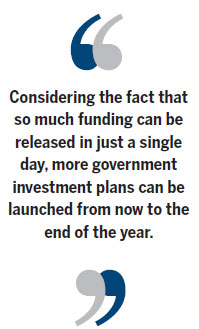Dire economic predictions prove useful
Updated: 2015-06-12 06:39
By Ed Zhang(China Daily Europe)
|
|||||||||||
Such forecasts serve as reminders for decision makers on what to avoid
The reason so many forecasts of China's economic collapse have failed to prove anything close to the truth is that, while seeming to be based on at least some facts, they have helped remind Chinese decision makers and managers of the problems they have to avoid.
They have helped create a kind of pressure, so to speak, for them to always answer to themselves (before showing the world) whether what they do will be sustainable. They have to make sure that their policies will result in at least an increasing sense of certainty, and at best a workable model, of steady growth.
For the last couple of years the decision makers have tried very hard to bring about such a long-term effect, despite many short-term difficulties.

Earlier this month, when one heard Premier Li Keqiang speak in front of representatives of some of the largest international corporations of his confidence in China's annual 7 percent growth in GDP "for a fair period of time to come", one can get some sense that the economy's ongoing slowdown is about to hit its bottom.
First of all, figures are unlikely to get much uglier in the last few months of the year, simply because the economy's performance was already sluggish in the second half of last year.
Second, as Li said, China can continue generating important growth by exploiting the discrepancies between its newly industrialized coasts and still underdeveloped central and western regions.
To narrow down regional developmental discrepancies, in the Chinese political lexicon, can carry a lot of meaning, starting with building major public infrastructure, such as roads, railways, airports and connections with foreign countries.
What Li indicated was that whenever the economy needs to pick up overall growth, China just has to embark on a few more big-ticket infrastructure projects to more closely connect its coastal regions with central and western regions.
Proof was furnished almost right away. The National Development and Reform Commission announced on June 10 its approval of 126.7 billion yuan ($20.4 billion; 18 billion euros) in new investment in large infrastructure, including expansion of one airport and the building of three new airports and two railways.
Considering the fact that so much funding can be released in just a single day, more government investment plans can be launched from now to the end of the year.
To boost the growth rate by spending more on infrastructure building looks like a boring game in China because it has been done so many times in recent years. But it works better than other ways of boosting growth by bringing money directly to the workers - in their wages, which they can immediately spend, and by bringing future business opportunities to the so-far underdeveloped central and western towns.

Local people welcome new infrastructure, especially the high-speed railways, because they tend to increase their tourism revenue.
Indeed, with China investing more in foreign countries, such a practice may even be exported.
In the meantime, one should also notice what Chinese officials do not usually talk about on the problems they face, urban employment for instance.
For all China's growth slowdown and related problems, and for its need for about 6 million new jobs for college graduates every year, it does not appear to be in an employment crisis. In the large cities like Beijing, Shanghai and Shenzhen, low-skilled jobs are taken by migrant workers from more distant rural towns.
By posting a resume online, middle-aged professionals with good skills or experience in leadership positions will easily be pursued by three to four potential employers, each offering a higher salary.
And the job market points to one other aspect of the economy: There are new companies and new growth industries, although most are still small, too small to offset the decline of old-fashioned steel mills and textile factories.
But those small companies will keep growing, now that the government's main policy orientation is to cut down on red tape and facilitate their growth.
The author is editor-at-large of China Daily. Contact the writer at edzhang@chinadaily.com.cn
(China Daily European Weekly 06/12/2015 page13)
Today's Top News
Zhou Yongkang sentenced to life in prison
Kiev announces new round of peace talks on Ukraine crisis
Greece, EU powers agree to step up debt talks as crunch looms
EU sanctions hamper Italian-Russian commercial ties: Putin
Suu Kyi begins groundbreaking visit
G7 'ignore the facts over South China Sea'
British PM hails 'golden year' in UK-China relations
China's new rail giant bags first overseas deal from India
Hot Topics
Lunar probe , China growth forecasts, Emission rules get tougher, China seen through 'colored lens', International board,
Editor's Picks

|

|

|

|

|

|






